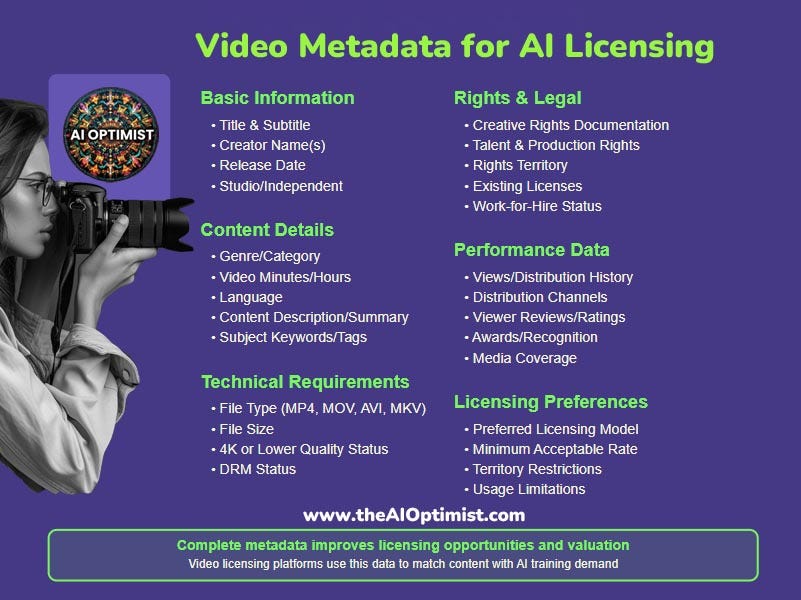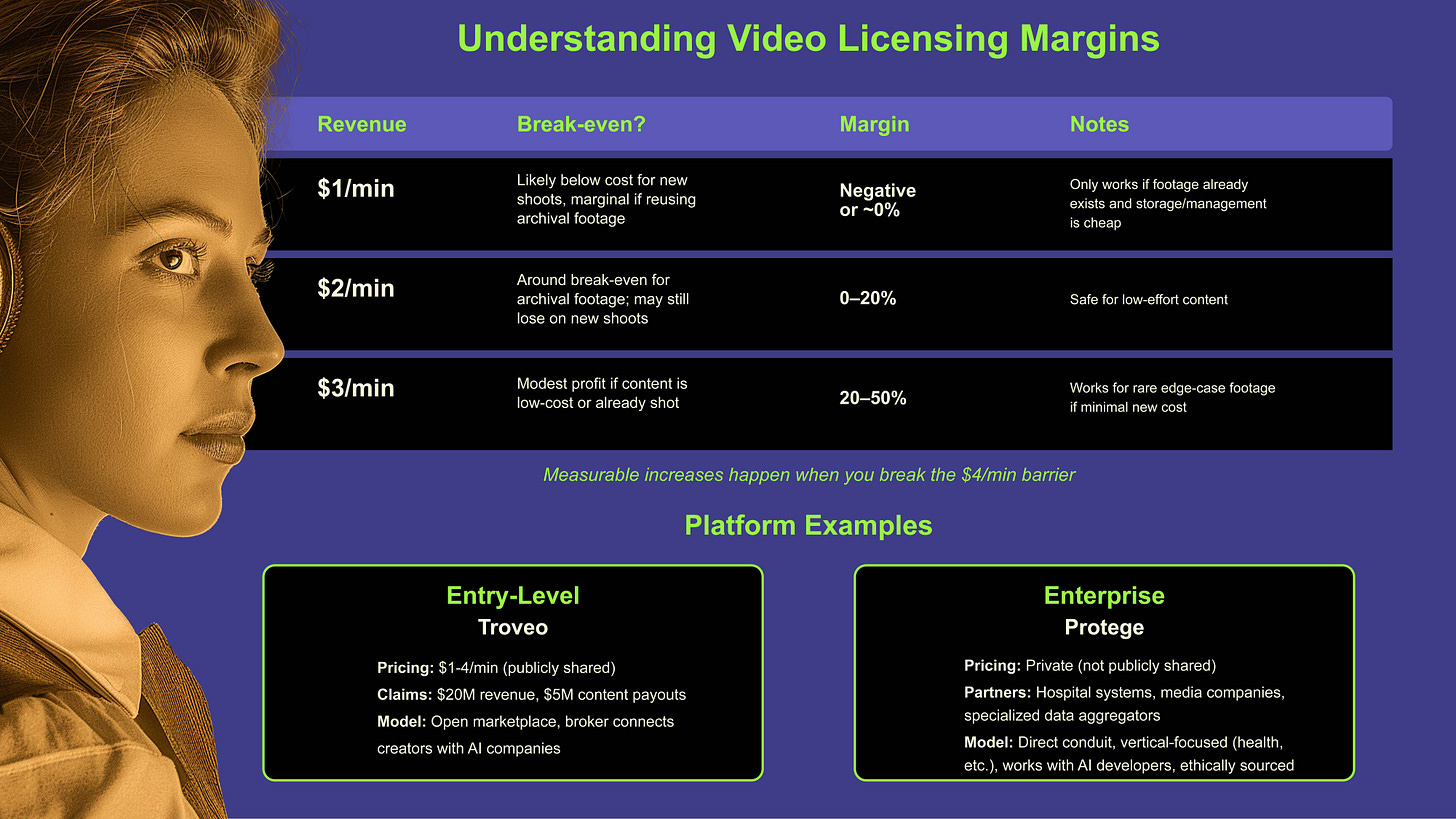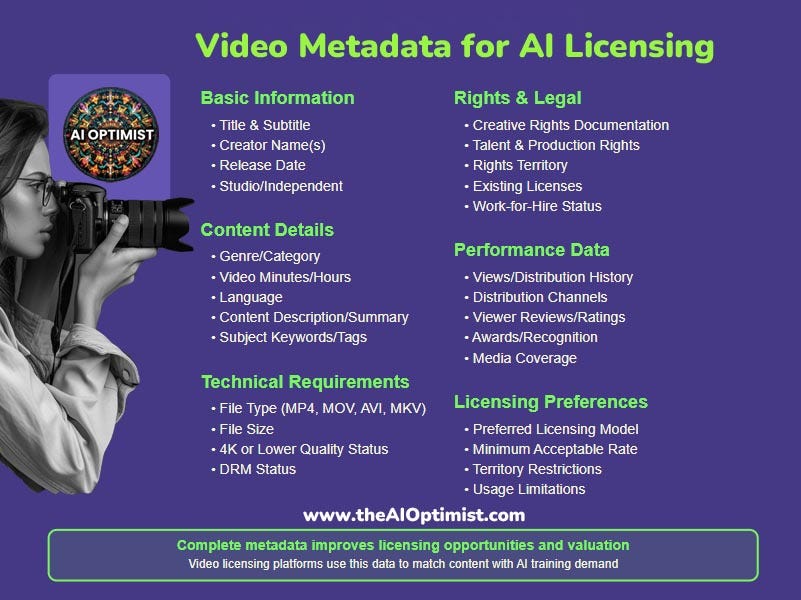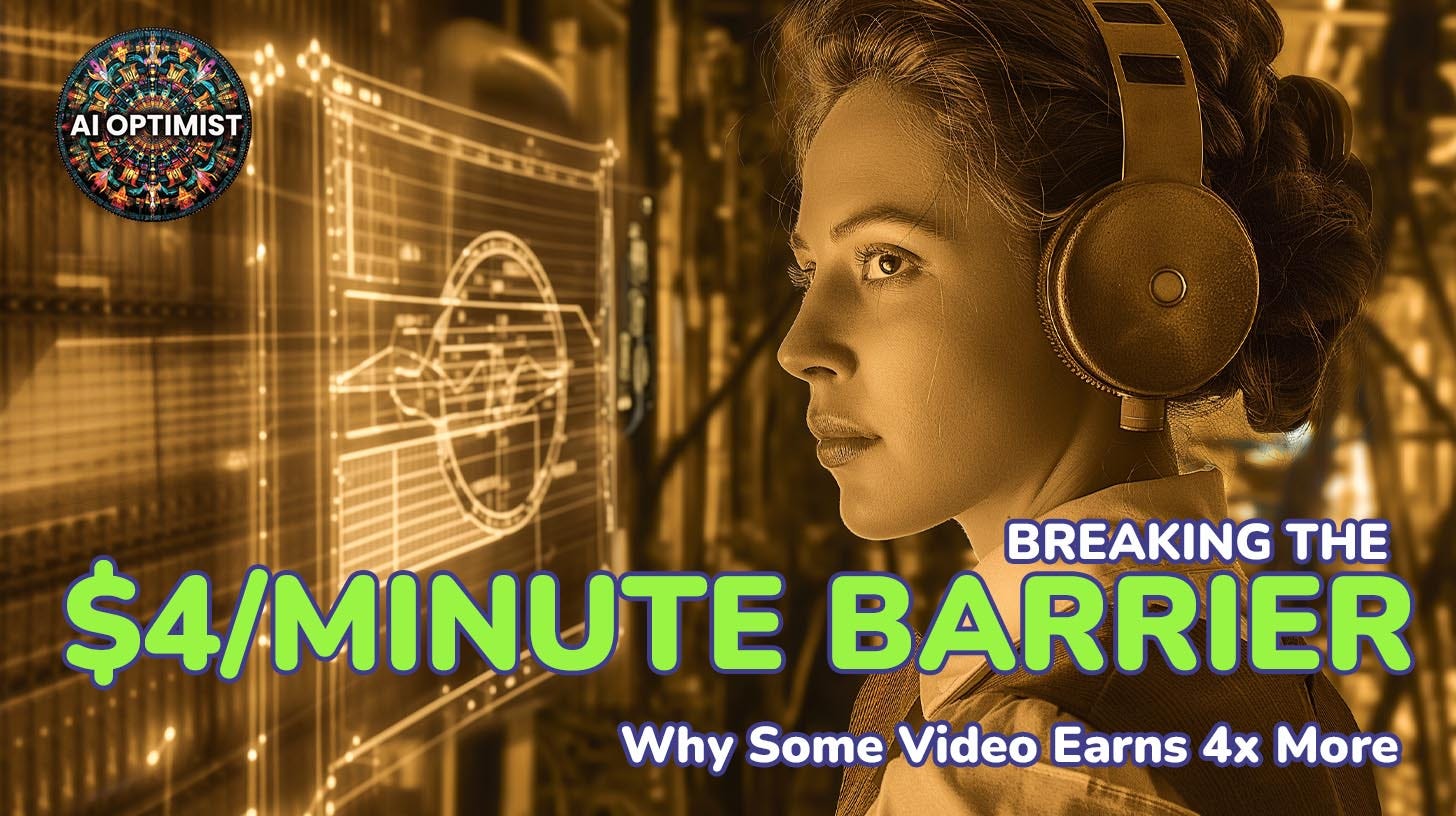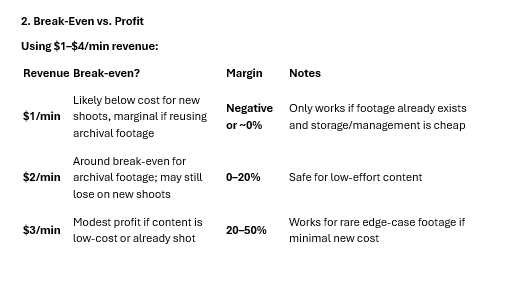When Hollywood’s Catalog Isn’t Enough and Might Need AI Licensing
Lionsgate thought they had this figured out.
The studio that owns John Wick, Twilight, and The Hunger Games partnered with Runway AI in 2025 to build custom video models. The vision? Type “anime version of John Wick” and watch AI generate it from their catalog.
That was around June 2025. Last week, the experiment quietly closed.
The problem wasn’t incompetence, it was scale.
Let’s do the math: 8,000 movies at roughly 2 hours each equals 16,000 hours.
Add 9,000 other titles averaging 1 hour, and you’re at maybe 25,000 hours total.
Double that generously to 50,000 hours.
Still not enough.
AI companies are running out of training data after burning through the entire internet. Video. Real, diverse, messy human video has become a bottleneck.
While Lionsgate struggled with insufficient data, one Troveo client was reportedly in the market for 50,000 hours of dog videos because their AI-generated dogs kept coming out with cat bodies.
That’s not a business model. That’s market unpredictability.
And it’s also a signal that unused footage sitting on your hard drive might have value you haven’t considered.
Not as content for views or sponsorships, but as possibly valuable data for machines learning to understand our world.
Questions to ask yourself:
How much unused footage do you have archived?
What categories does it fall into—nature, urban environments, specialized activities?
Do you own all rights, or are there B-roll clips, music, or people who’d need to sign off?
The Current Market Reality—What We Know
Let’s separate signal from speculation.
Troveo, a video licensing platform connecting creators with AI companies, claims $20M in total revenue with $5M paid to creators.
I use $1-4 per minute as a range for this episode. My reasoning is Troveo is on the lower end of video AI licensing usually $1-3 a minute.
It’s likely larger companies like Protégé are also getting paid. We don’t know how much. My assumption is the amount is higher, likely much higher.
So I add $1 on the low end of pricing. And urge you all to look at going beyond $4 a minute, a tough and still more sound business than the wholesale $1-2 market. And it may just be what it is, a small market.
This is one of the few companies publishing numbers instead of hiding behind NDAs. That transparency matters.
Also means we’re looking at early-market indicators, not established rates.
Here’s what the pricing tiers appear to reflect:
$1-2/minute (Standard Footage):
Talking heads
Predictable motion
Common scenarios
Already-seen angles
$3-4/minute (Premium/Edge Cases):
Rare weather phenomena
Unusual wildlife behavior
Technical processes under stress
Unique temporal transitions
The Tesla framework helps understand this distinction—not because they’re licensing video, but because they’ve quantified what makes training data valuable.
Highway driving footage is standard.
A deer crossing during a snowstorm at night is premium.
It’s not about monetary pricing; it’s about learning density.
Most Tesla footage comes from user cars, with operational costs built into the product, not per-minute purchases.
But their internal categorization reveals something useful: edge cases, rarities, and uniqueness teach AI systems more than repetitive standard scenarios.
The break-even reality check:
Look at the view of the market, knowing most of the business now is $1-2 per minute.
The threshold where this becomes a legitimate side revenue stream
This is why the $4/min barrier matters.
Below that, you’re liquidating existing assets at thin margins. Above it, potentially building a sustainable side business.
This is a one-time payment market.
You’re not building recurring revenue. You’re selling training data that will likely be used to eventually replace the need for more training data.
And for anything above $3 a minute, 4K is the rule. Other footage likely goes into the $1-2 pile, why you see garage sales of old content, some valuable and most not.
Action steps for this section:
Calculate your actual production costs per minute for different types of footage
Audit your archive—how many minutes of different quality levels do you have?
Tag footage by category: nature, urban, people-heavy (complications), specialized technical
For each category, honestly assess: standard or edge case?
Permissions: who was in front of the camera, who was behind, and who was the producer? Signing off slows down AI licensing. Make sure your video is clear and clean with ownership and permission.
What Makes Video Actually Valuable
AI systems extract something from video that text and images can’t provide: motion, causality, temporal relationships, and context.
Would this video pass the AI Licensing test?
Mira Murati, founder of Thinking Machines Lab, says:
“We’re building multimodal AI that works with how you naturally interact with the world—through conversation, through sight, through the messy way we collaborate.”
That messiness, the unscripted, unedited reality contains teaching moments machines can’t get elsewhere.
Compositional rarity matters: unusual angles, unexpected framing, perspectives humans naturally avoid. We shoot at eye level. We center subjects. AI needs overlooked angles.
Temporal uniqueness creates value: time-lapses showing weather transitions, seasonal changes, processes that unfold over hours compressed into minutes. The dimension of time is where video is separated from images.
Technical mastery in specialized domains: industrial processes, scientific phenomena, professional techniques that rarely get documented at high quality.
Video content may work, but here’s where most creators will hit the wall: rights and metadata.
Look at the metadata requirements. You need:
Title, subtitle, creator names, release date
Studio/independent status
Creative rights documentation (who owns what)
Talent and production rights (every person visible)
Rights territory and existing licenses
Work-for-hire status
Genre/category classification
Exact video minutes/hours
Language
Content description and summary
Keywords and tags
Views/distribution history
Distribution channels used
Viewer reviews/ratings if applicable
Awards and recognition
Media coverage
This isn’t “throw files in a zip folder and get paid.” This is treating your footage like a professional asset.
The legal complexity escalates with people. Every identifiable face needs a signed release. Every location might need permission. Every piece of music requires clearance.
This is why nature footage, weather phenomena, and process documentation are the cleanest paths. No talent releases. No location complications. Just you, a camera, and something worth documenting.
The Facts: Many avoid, a few automate with AI
Most creators won’t do this work. The administrative overhead eliminates casual participants. That means less competition for those who take it seriously.
Practical experiment (inspired by Tesla’s approach):
Take 10 minutes of your archived footage. Watch it with fresh eyes and categorize every 60-second segment:
Standard: Could this be filmed by thousands of other creators? Common angle, predictable motion, everyday scenario?
Premium: Is there something unusual here? An unexpected perspective, rare moment, technical complexity, or temporal uniqueness?
Be brutally honest. Most footage is standard. Still it has value. But understanding the ratio helps you know whether you’re sitting on $1/min inventory or $4/min.
Action steps:
Conduct the standard vs. premium analysis on a sample of your footage
4K is the cut off line to $3-4 a minute, and that’s not a guarantee. Lesser quality probably means low end pricing.
Make a list of locations, subjects, or processes you could access that others can’t
Research what’s already available. If 10,000 creators have time-lapses of the Golden Gate Bridge, yours isn’t premium
Identify your unique angle: local access, specialized knowledge, unusual timing, technical skills
The Path Forward:
Find Demand Before Supply
The mistake most creators make: assuming supply creates demand.
It doesn’t. Not in this market.
The smarter approach: research demand signals before you shoot another frame.
Where to look for demand signals:
Study existing platforms (without committing yet):
Troveo shows public categories: nature, sports, new media, scripted vs. unscripted
Notice what’s featured, what categories dominate
This reveals some current demand patterns
Enterprise-level signals:
Protege (enterprise-focused, doesn’t list pricing publicly—that’s actually a positive signal)
They work with hospital systems, media companies, specialized data aggregators
Private pricing suggests higher-value transactions with volume requirements
The unpredictability factor:
Remember the 50,000-hour dog video request? That probably won’t repeat.
But it illustrates how urgent, specific needs create temporary premium pricing
The lesson: diversification and patience matter more than chasing trends
To make this work, minimize:
Editing time (raw or minimal editing only)
Rights clearance complexity (avoid people when possible)
Metadata preparation overhead (build templates, automate tagging)
Storage and management costs (organize before you need to)
And maximize:
Footage quality (4K minimum for premium rates)
Rights clarity (know what you own completely)
Category alignment with demand (follow platform signals)
On time, every time (capture more in less shooting time)
Reality check on current platforms:
Troveo operates as an open marketplace—entry-level, broker model connecting individual creators with AI companies.
Claims of $1-4/min are starting points, not guarantees. These numbers will go up and down over time. Watch for these as a moving baseline of pricing, for a market figuring it out.
Protege works at enterprise scale—direct conduit model, vertical-focused (healthcare, specialized domains), requires significant volume and ethical sourcing. They don’t publish rates.
Neither model guarantees income. Both require patience, quality standards, and realistic expectations about one-time payments in an early market.
Action steps:
Don’t do anything new yet. Start with archives.
Pick one category where you have 20+ minutes of quality footage
Research that specific category: Who’s buying it? What are the metadata requirements? What’s the going rate range?
Prepare metadata for a test batch—treat this like a learning exercise, not a revenue projection
If you decide to submit, track time invested vs. payment received for accurate ROI assessment
Should You Actually Do This?
This is not passive income. The administrative work, like metadata preparation, rights documentation, platform navigation takes time.
At $1-2/min for standard footage, you’re essentially working for minimum wage unless you have massive archives already organized.
This is not recurring revenue. One-time payments mean you’re liquidating assets, not building sustainable business models. The footage you sell today trains the models that might reduce demand tomorrow.
This is market timing, not market certainty. Early movers might capture premium pricing. Late arrivals will face commoditized rates and saturated categories.
Who should seriously explore this:
✅ Videographers with extensive, organized archives gathering dust
✅ Creators with unique access to rare locations, events, or phenomena
✅ Technical specialists who regularly document processes others can’t
✅ Anyone willing to treat this as a 2-3 year experiment, not a career pivot
✅ People who enjoy systematization and documentation
Who should probably skip it:
❌ Anyone expecting quick money without organizational work
❌ Creators with people-heavy footage requiring extensive rights clearance
❌ Those hoping for recurring licensing income
❌ Anyone needing guaranteed returns to justify time investment
❌ Creators uncomfortable with one-time payment models
The 2-3 year window hypothesis:
This market likely has a limited lifespan. As wearables multiply, omnipresent cameras proliferate, and synthetic data generation improves, the premium on human-captured footage will shift. Not disappear, evolve.
Right now, there’s an insatiable appetite because AI companies burned through internet video and discovered it’s not enough. That’s a temporary condition, not a permanent feature.
Even if you never license a single minute, this exercise reveals something valuable: what makes your video data premium vs. standard from an AI learning perspective.
That understanding informs how you think about your own AI tools. If your footage would be standard-tier training data, maybe your internal use should focus on templates and efficiency.
If your footage captures edge cases, maybe your AI applications should emphasize unique scenarios and specialized knowledge.
Final action framework:
🔍 Research phase (Week 1-2):
Audit archives
Categorize by rights clarity (clean, complicated, impossible)
Study demand signals on existing platforms
Calculate ROI based on current rates
📋 Test phase (Week 3-4):
Prepare metadata for 20-30 minutes of your cleanest footage
Submit to one platform as learning exercise
Track time invested in preparation
Document platform experience
📊 Evaluation phase (Week 5-6):
Calculate actual time investment vs. payment received
Assess whether scaling makes sense
Decide: expand, pause, or abandon
💡 Strategic learning (Ongoing):
Use the premium vs. standard analysis for your own AI workflows
Notice what edge cases exist in your domain
Consider whether creating future content with dual purpose (use + licensing) makes sense
The Market is real and forming….
Video training for AI represents a real, if unpredictable, market. Companies like Troveo are paying creators.
Demand signals exist. The data shortage is genuine.
But it’s not a gold rush.
It’s an early-stage market formation with volatility, one-time payments, and a lot of admin overhead.
The $4/min barrier isn’t just about money.
It’s the threshold where this transitions from “liquidating old footage at thin margins” to “potentially worthwhile side revenue stream.”
Most footage won’t break that barrier. Most creators won’t want to do organizational work.
For those who find the intersection of unique access, clean rights, and serious systematization appealing?
There’s a 2-3 year window to explore carefully, with eyes open and forget expectations. Watch market patterns, what they do, not what they say.
The question isn’t whether AI companies need video training data. The question is whether licensing video to AI for your specific situation, with your specific archives, given your time, is worth it.
Only you can answer that.
I’d like to know what you’d add, ask, and want to know.
Want to explore this further? I’m documenting my own testing process at The AI Optimist. No guarantees, just testing out the tools and giving AI a chance to grow as an industry.
RESOURCES
AI Companies Running Out of Training Data After Burning Through Entire Internet
Everyone Is Already Using AI (And Hiding It)
Influencers are making big money selling leftover videos — ones not yet posted online — to train AI
Mira Murati and the New Frontier of AI Innovation
Deep Dive into Yann LeCun’s JEPA
AI’s Next Five Years: LeCun Predicts a Physical-World Revolution
AI Optimist Playlist (Shorts and Sections)



